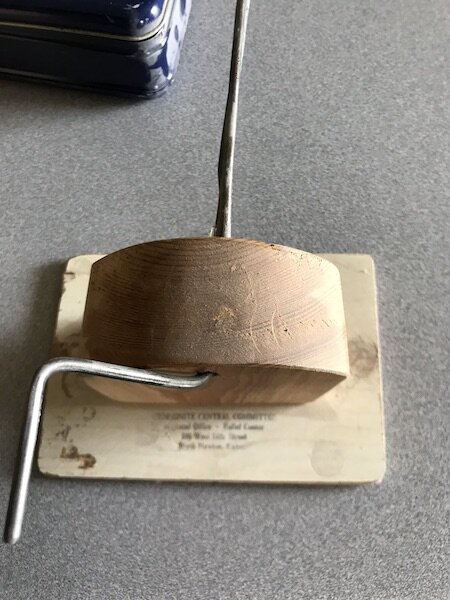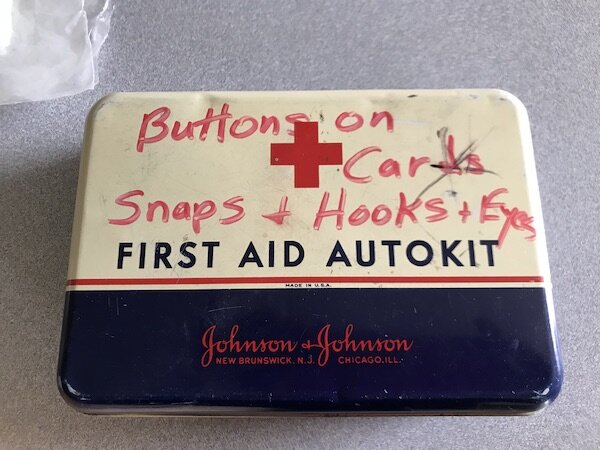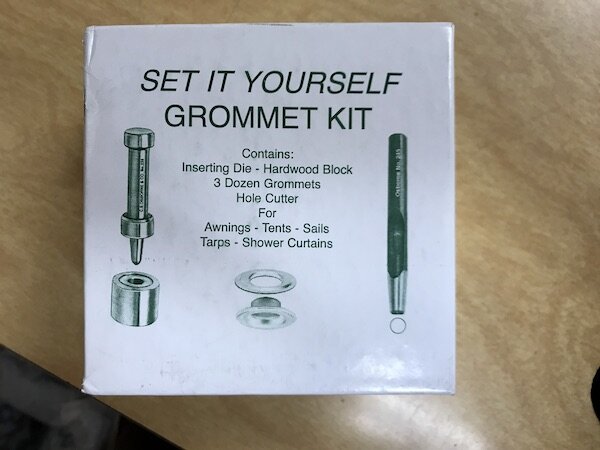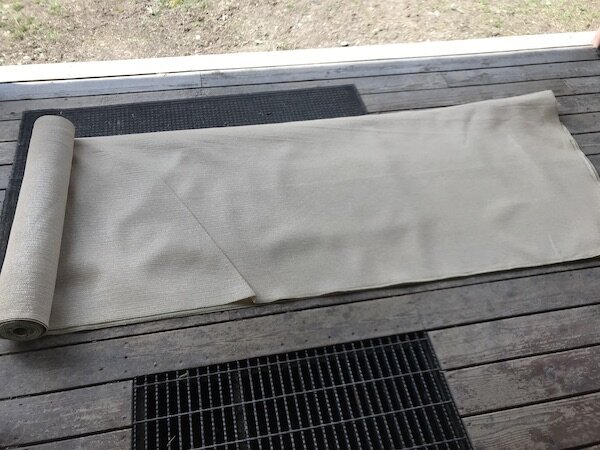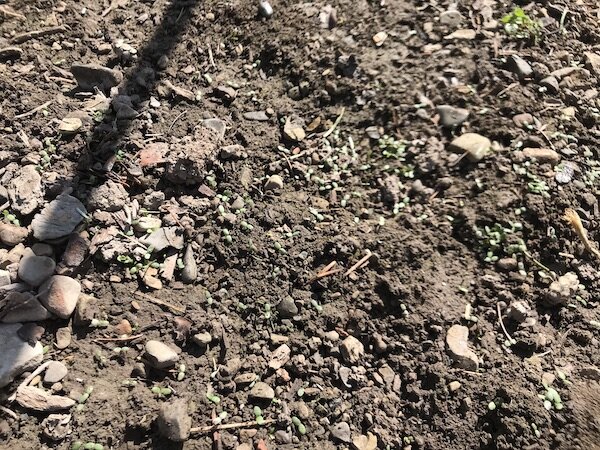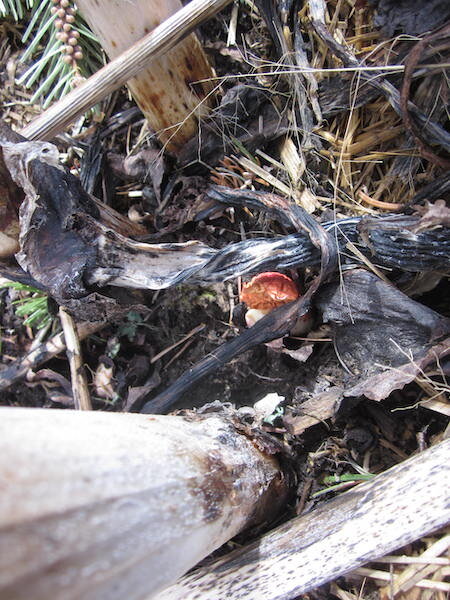I planted three varieties of cowpeas 2-3 days apart; this was the last variety I planted and the first to sprout. This is “Fast Lady Northern Southern Cowpea.” It was developed in Oregon by Carol Deppe for cooler climates, so no surprise that it was the first to come up. I planted this variety directly into the garden last year—too late, I think—and it came up and flowered but didn’t produce any pods. Hopefully, starting it in the greenhouse will give it the extra time it needs.
I went a bit nuts with the corn this year. A few seasons ago, we grew some Painted Hill corn that we got from Victory Seeds in Oregon. It did very well for us. I blanched and froze it for adding to soups and stews. The kernels are a variety of dark jewel-toned colors. The description on the Victory Seeds website says:
'Painted Hill' was bred by Dr. Alan Kapuler of Peace Seeds who stabilized a cross between Dave Christensen's genetically diverse 'Painted Mountain' grain corn and the old heirloom, 'Luther Hill' sweet corn.
Baker Creek carries Painted Mountain (although they are sold out for this season). Here is their description:
This corn is the very definition of rugged beauty! These incredibly tough plants were bred in the bitter cold mountains of Montana. They boast impressive cold hardiness, earliness, drought tolerance, and they thrive at high altitudes. Montana farmer Dave Christensen has dedicated his life’s work to naturally breeding a corn that will thrive in harsh conditions, and since the 1970s has sampled from over 70 open-pollinated varieties of corn to create Painted Mountain corn. These are old heirlooms grown by northern Native American tribes over thousands of years, as well as homesteaders from harsh northern climates.
I bought some Painted Mountain seed this year because I am curious to see how it compares to Painted Hill (which I am growing again).
Just for fun, I bought a packet of Montana Cudu from Baker Creek (also sold out for 2020). This has been developed by another Montana corn breeder:
A beautiful spotted variety that is descended from a historic Native American variety. Ed Schultz, renowned corn breeder from Montana, has worked to adapt a blended corn as a tribute to a sacred Native American variety. Cudu corn is said to be an ancient native American variety used for sacred ritual. A sample of seeds was donated to the USDA seed bank by Oscar Will in 1958. The original donated seed may have been accidentally inbred or crossed, as the cobs were stunted and short, and kernels had begun to lose their signature blue eagle marking. Ed is a far northern grower who has worked to create beautiful and early-maturing corns like Atomic Orange and the Papa’s corn. He received a sample of seeds from the USDA and has worked for over five years to adapt it to his northern region and to create longer cobs. He reports that this variety has long, slender ears and beautiful blue-spotted kernels. To achieve this variety, he bred true Cudu corn with a small percentage of Papa’s White corn.
And some Montana Lavender Clay corn (no doubt you are sensing a pattern here). This is another Ed Schultz-developed variety (again, sold out for 2020):
One look at the unmistakable lavender kernels shows that this blended Native American variety is descended from the lavender parching corn of the Mandan tribe. In 1808, Thomas Jefferson received seeds of a lavender colored, Mandan Red Clay corn; he reported that the seeds were given to him by Lewis and Clark from their 1804 contact with the Mandan tribe in present day North Dakota. Schultz has taken the lovely lavender-clay color and rugged cold hardiness of Mandan corn while making for more slender and uniform ears and short, stout plants. A stellar feat of breeding from a solid foundation of superlative ancient genetics.
I am all for old, open-pollinated varieties. I started seed from each of these varieties and we will see how they do in the garden this year.
I’ve also got a pot with two special tomato seeds in it. Susan ordered some seeds of a variety known as “Dirty Girl” and shared them with several of us in the neighborhood. If we all grow these and save seeds, we can keep the mutual gene pool bigger. (We are so fortunate to have a resident botanist!)
**************************************************
I voluntarily furloughed myself from work as of yesterday. We cleared the backlog from last month and work slowed to a trickle. I know the other transcriptionists depend on that income and I don’t. What I need now is time to work in the garden. My supervisor was fine with that decision and promised to let me know when they need me again.
I spent some time tinkering with the coverstitch machine yesterday afternoon (it was still snowing). Mine is a Janome CoverPro 1000. At the time I bought it, about three years ago, there were not a lot of domestic coverstitch machines available and not much information on their use. I got the hang of mine quickly, but I was baffled by the fact that the mechanisms were so stiff. That didn’t make any sense to me. And all of these modern machines come with admonitions not to oil. I realize the manufacturers want you to take them in for service periodically, and that especially makes sense with the electronic machines, but basic maintenance should be encouraged.
Thankfully, the wisdom of crowds came to the rescue. I joined a coverstitch group on Facebook and discovered that other CoverPro owners were opening up their machines and oiling them, with great results. That model also suffered from the problem of skipped stitches, which turned out to be a quality control issue having to do with the height of the feed dogs. I never had that problem, but the people who did and who adjusted the feed dogs were able to correct it.
In the last year or so, a bunch of new brands/models of coverstitch machines have hit the market. Some are serger-coverstitch combo machines and some are coverstitch-only machines. I think Janome missed an opportunity to take the lead in that market when they put out machines with obvious flaws.
In any case, I did open mine up and oiled it with some BlueCreeper sewing machine oil. It runs much more smoothly now. I’ll re-thread it and finish the hems on that Gap knockoff dress. And I’ve started another batch of masks.


